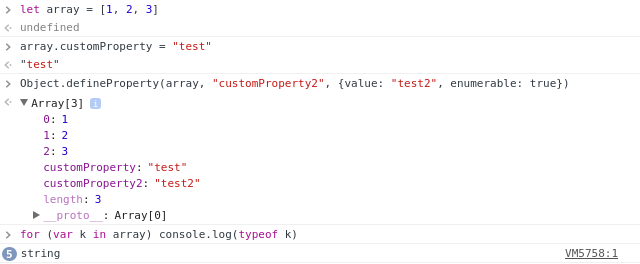JavaScript "in" Confusion
javascriptThe in operator, when used with arrays in JavaScript, comes with a little nuance and may
be the cause of some confusion. The in operator is strictly used to tell whether a given
property name exists in an object or its [[Prototype]] chain (and is enumerable, but
we’ll cover that later). So how does this work for arrays? It’s tempting to think 2 is
in [1, 2] but this will return false.
Why?
Arrays are really just objects with integer-looking property names. So in the above example,
both 0 and 1 are in [1, 2] just as 0 and 1 are in [99, 100]. But wait, you may have
heard that all object property names in JavaScript are strings, so how does the array allow
integer indexing and in checking?
You’re probably used to referencing elements in an array by passing some integer to the bracket
operator like this: array[0] right? For example, the following array appears to have integer
property names:

But in reality, array property names (you know them as indices) are strings just like in the object below.

The reason that 0 in array works just as well as 0 in object and "0" in object is because of
JavaScript type coercion. Yes, it is exactly what it sounds like. When checking property existence
with an integer, JavaScript coerces the integer into becoming a string by calling toString() before
the property lookup.
Prove it Dom
So given our previous evidence, it makes sense to say there is some equivalence between 0 and "0",
and in fact there is! This is precisely why the language has the triple or “strict” === equals
operator. In JavaScript, 0 == "0" beacuse type coercion can make their values equivalent. This
means array[0] really makes the interpreter say
“Hey, is there some property name on this object that == 0?”.
On the contrary, 0 === "0" will return false.
Now that we know in evaluates the existence of a property in some object, it should be fairly
obvious that a for..in loop will iterate through all of the enumerable properties in some object.
I say enumerable properties because if a property’s data descriptor has {enumerable: false}, it
will not show up in a for..in loop. Even though it is still accessible via a regular call to in
outside of a loop.
Consider the following example showing that arrays are just augmented objects:

in vs hasOwnProperty
In the second sentence of this post, I alluded to the fact that in checks not only some given
object for property existence, but also its [[Prototype]] chain. This is a subtle but important
detail. If you want to check for property existence only in some object, while not consulting
its [[Prototype]] chain, you should use .hasOwnProperty() available to any object through
Object.prototype.hasOwnProperty. This final example should sum up the details:
